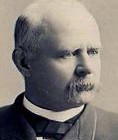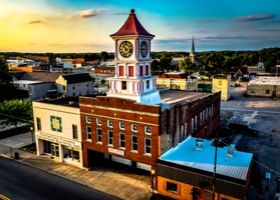Adlai Ewing Stevenson was born to, John Turner Stevenson and Eliza Ewing Stevenson who had located in Kentucky in 1813. Stevenson was born on the family farm in Christian County, Kentucky. He attended the common school in Blue Water, Kentucky. In 1852, when he was 16, frost killed the family’s tobacco crop. His father set free their few slaves and the family moved to Bloomington, Illinois, where his father then operated a sawmill. Stevenson attended Illinois Wesleyan University at Bloomington and ultimately graduated from Centre College, in Danville, Kentucky; at the latter he was a part of Phi Delta Theta. His father’s death prompted Adlai to return from Kentucky to Bloomington to run the sawmill.
At age 23, he began practicing law in Metamora, in Woodford County, Illinois. As a young lawyer, Stevenson encountered such celebrated Illinois attorneys as Stephen A. Douglas and Abraham Lincoln, campaigning for Douglas in his 1858 Senate race against Lincoln. In a predominantly Republican area, the Democratic Stevenson won friends through his storytelling and his warm and engaging personality.
In 1874, Stevenson was elected as a Democrat to Congress, serving from 1875-1877. In 1876, Stevenson was an unsuccessful candidate for reelection with a narrow defeat. In 1878, he ran on both the Democratic and Greenback tickets and won. In 1880, he once more lost narrowly, and he lost again in 1882 in his final race for Congress.
Stevenson served as first assistant postmaster general under Grover Cleveland in 1885. During that time he fired over 40,000 Republican workers and replaced them with Democrats from the South. The Republican-controlled U.S. Congress did not forget this: when Stevenson was nominated for a federal judgeship, he was defeated for confirmation by the same people who never forgot his 1885 purge.
In 1892, when the Democrats chose Cleveland once again as their standard bearer, they appeased party regulars by the nomination of Stevenson for vice president. The winning Cleveland-Stevenson ticket carried Illinois, although not Stevenson’s home district.
Adlai Stevenson enjoyed his role as vice president, presiding over the U.S. Senate, where he won praise for ruling in a dignified, nonpartisan manner. In personal appearance he stood six feet tall and was “of fine personal bearing and uniformly courteous to all.”
After the 1900 election, Stevenson returned again to private practice in Illinois. He made one last attempt at office in a race for governor of Illinois in 1908, at age 72, narrowly losing. After that, he retired to Bloomington, where his Republican neighbors described him as “windy but amusing.” He died in Chicago on June 14, 1914. His body is interred in a family plot in Evergreen Cemetery, Bloomington, Illinois. Stevenson’s son, Lewis G. Stevenson, was Illinois secretary of state (1914–1917).
Stevenson’s grandson Adlai Ewing Stevenson II was Democratic candidate for President of the United States in 1952 and 1956 and Governor of Illinois. His great-grandson, Adlai Ewing Stevenson III, was a U.S. senator from Illinois from 1970 to 1981 and an unsuccessful candidate for Governor of Illinois in 1982 and 1986.





